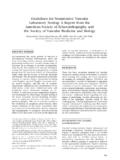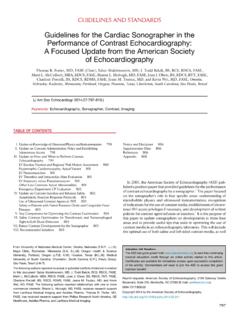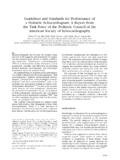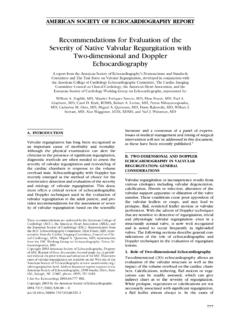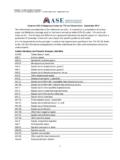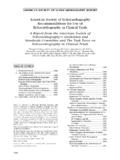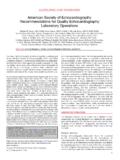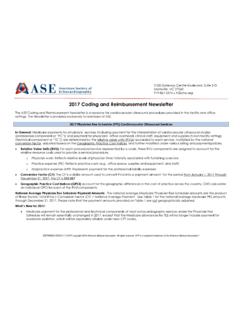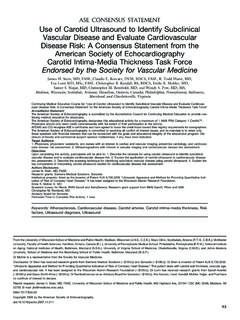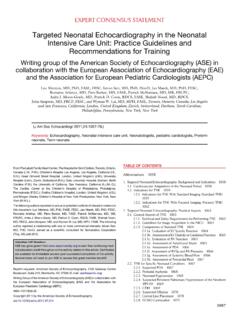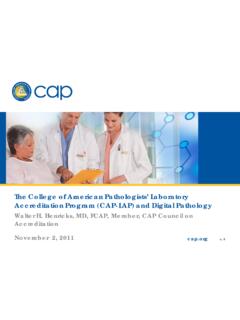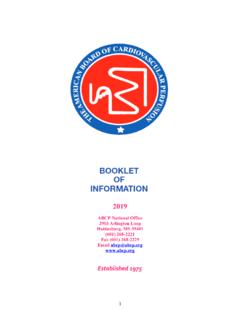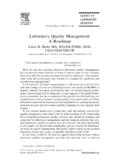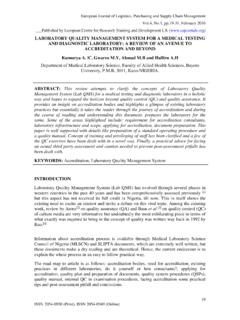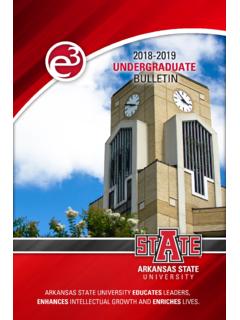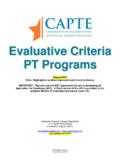Transcription of American Society of Echocardiography Recommendations for ...
1 GUIDELINES AND STANDARDSA merican Society of EchocardiographyRecommendations for Quality EchocardiographyLaboratory OperationsMichael H. Picard, MD, FASE, David Adams, RDCS, FASE, S. Michelle Bierig, RDCS, MPH, FASE,John M. Dent, MD, FASE, Pamela S. Douglas, MD, FASE, Linda D. Gillam, MD, FASE, Andrew M. Keller, MD, FASE,David J. Malenka, MD, FASE, Frederick A. Masoudi, MD, MSPH, Marti McCulloch, RDCS, FASE,Patricia A. Pellikka, MD, FASE, Priscilla J. Peters, RDCS, FASE, Raymond F. Stainback, MD, FASE,G. Monet Strachan, RDCS, FASE, and William A. Zoghbi, MD, FASE,Boston, Massachusetts; Durham, North Carolina;St. Louis, Missouri; Charlottesville, Virginia; New York, New York; Danbury, Connecticut;Lebanon,NewHampshire;Denver, Colorado; Houston, Texas; Rochester, Minnesota; Pennsauken, New Jersey; San Diego, CaliforniaKeywords: Echocardiography , Quality, Echocardiography laboratory operationsEnsuring a high level of quality in Echocardiography is a primary goalof the American Society of Echocardiography (ASE).
2 Establishinga definition of quality in cardiovascular imaging has been challenging,and there has been limited agreement on quality standards for imag-ing. Quality can be measured as adherence to established guidelinesfor the use of a technology to ensure patient satisfaction andoutcomes. However, specific criteria to ensure quality must be estab-lished for each phase of the process, from considering a test for a pa-tient to incorporating the results of the test appropriately into patientcare. The purpose of this report is to provide a framework forechocardiographic quality assessment and improvement. Becausethis report builds on prior ASE efforts in this arena, some of therecommendations have been presented thisdocument establishes guidelines in the various components of qualityin echocardiographic imaging services, the initial goal is to highlightgeneral Recommendations for minimum quality standards and pro-vide some numerical or threshold values for compliance.
3 Thus, thestandards recommended in this document are realistic goals for theaverage practitioner. Although these Recommendations focus onadult Echocardiography , most are applicable or can easily be modifiedfor pediatric, fetal, and intraoperative Echocardiography . Objectivestudies linking quality measures in Echocardiography to outcomesare frequently lacking, and thus statements expressed in thisdocument are based primarily on expert committee used the dimensions of care framework for car-diac imaging reported ,3 This model divides the process ofclinical Echocardiography into the laboratory structure and theimaging process. The imaging process can be further separated intofive areas that may influence patient outcome: patient selection,image acquisition, image interpretation, results communication, andthe incorporation of results into care.
4 In all of these domains,distinct benchmarks of quality can be STRUCTUREThe laboratory structure can be divided into a minimum of fourcomponents: the physical laboratory , the equipment, the sonogra-pher, and the physician. The ASE has previously addressed the issueof quality of the laboratory , sonographers, and physicians in itsproposed local coverage determination ( ).Physical LaboratoryExisting Echocardiography laboratories should be accreditedby the Intersocietal Commission for the accreditation ofEchocardiography Laboratories. New laboratories should have pro-cesses for moving the laboratories toward laboratory accreditationby submitting applications within 2 years of the onset of ASE recognizes that the process of lab accreditation is resourceintensive and may require the commitment of additional the Massachusetts General Hospital, Boston, Massachusetts ( ); DukeUniversity Medical Center, Durham, North Carolina ( , ); St.
5 Anthony sMedical Center, St. Louis, Missouri ( ); the University of Virginia HealthSystem, Charlottesville, Virginia ( ); Columbia University, New York, New York( ); Danbury Hospital, Danbury, Connecticut ( ); Dartmouth-HitchcockMedical Center, Lebanon, New Hampshire ( ); Denver Health Medical Center,Denver, Colorado ( ); Methodist DeBakey Heart & Vascular Center, Houston,Texas ( , ); Mayo Clinic, Rochester, Minnesota ( ); CooperUniversity Hospital, Pennsauken, New Jersey ( ); Texas Heart Institute at s Episcopal Hospital, Houston, Texas ( ); and the University of California,San Diego, California ( ).The following authors reported no actual or potential conflicts of interest in relationto this document: Michael H. Picard, MD, FASE; S. Michelle Bierig, RDCS, MPH,FASE; John M. Dent, MD, FASE; Pamela S.
6 Douglas, MD, FASE; Linda D. Gillam,MD, FASE; Andrew M. Keller, MD, FASE; Priscilla J. Peters, RDCS, FASE;Raymond F. Stainback, MD, FASE; and William A. Zoghbi, MD, FASE. The follow-ing authors reported a relationship with one or more commercial interests: DavidAdams, RDCS, FASE, serves as a consultant for Philips, Siemens, and GE. DavidJ. Malenka, MD, FASE, received grant support from St. Jude Medical A. Masoudi, MD, MSPH, received grant support from the National Heart,Lung, and Blood Institute and the Agency for Healthcare Research and McCulloch, RDCS, FASE, is a speaker for Lantheus and an advisor and con-sultant for Siemens and GE. Patricia A. Pellikka, MD, FASE, served as a consultantfor Novartis. G. Monet Strachan, RDCS, FASE, received a per diem from ASE Members:ASE has gone green! earn free CME throughan online activity related to this article.
7 Certificates are available for immedi-ate access upon successful completion of the activity. Non-members willneed to join ASE to access this great member benefit!Reprint requests: American Society of Echocardiography , 2100 Gateway CentreBoulevard, Suite 310, Morrisville, NC 27560 2011 by the American Society of , however, is not sufficient,as there are facets of laboratoryoperation and needs forlaboratory policies that are notcurrently addressed by thelaboratory accreditation processof the Intersocietal Commissionfor the accreditation ofEchocardiography example, in addition to thetypical methods for requestingan echocardiographic study,a mechanism should be in placefor ordering urgent echocardio-graphic studies and for commu-nicating the urgency of studiesto the laboratory staff members and interpreting physicians.
8 Thismechanism should be understood by all ordering support staff members should be available to assist withscheduling and reporting of studies and to ensure the timely relayof results to ordering clinicians. Sufficient laboratory staff membersmust be able to recognize and respond to common medical emergen-cies and have competency in basic life support laboratory space must have the necessary sanitizing equip-ment, ranging from a designated room to perform high-level disinfec-tion of transesophageal echocardiographic (TEE) probes to necessarycleansing products for the transthoracic echocardiographic (TTE)transducers, ultrasound machines, and beds. Sinks and approvedhand cleaners must be readily available in each area in which echocar-diography is equipment available for the performance of echocardiographicprocedures must be capable of performing two-dimensional,M-mode, and color and spectral (both flow and tissue) Doppler imag-ing.
9 The display must be able to identify the institution, patient name,and date and time of study. The electrocardiogram and depth or flowvelocity calibrations must be present on all displays. The machinesshould have the capability to display other physiologic signals, suchas phases of respiration. If the laboratory performs stress echocardiog-raphy, a sufficient number of machines must have software that al-lows split-screen and quad-screen display for simultaneous imagecomparison. Transducers that can provide high-frequency and low-frequency imaging, as well as a dedicated nonimaging continuous-wave Doppler transducer, must be available for laboratories must have transducers that coverthe proper frequency range for high-resolution imaging of patientsof the variety of sizes present in the pediatric imaging probes should be multiplane.
10 All machinesshould have harmonic imaging capabilities and other instrumentsettings to enable the optimization of both standard and contrast-enhanced ultrasound machine must also have a digital image storage method thatshould be compatible with Digital Imaging and Communications inMedicine images must be maintained for the timeperiod mandated for medical record retention in individual agents and intravenous supplies should be available forstaff members to use for patients who are difficult to imaging beds, which include a drop-down portionof the mattress to facilitate apical imaging, are required to treat medical emergencies, including oxygen,suction, and code carts, must be accuracy of all laboratory imaging equipment should be tested,and laboratories should adhere to manufacturers recommendationsregarding preventive maintenance.
